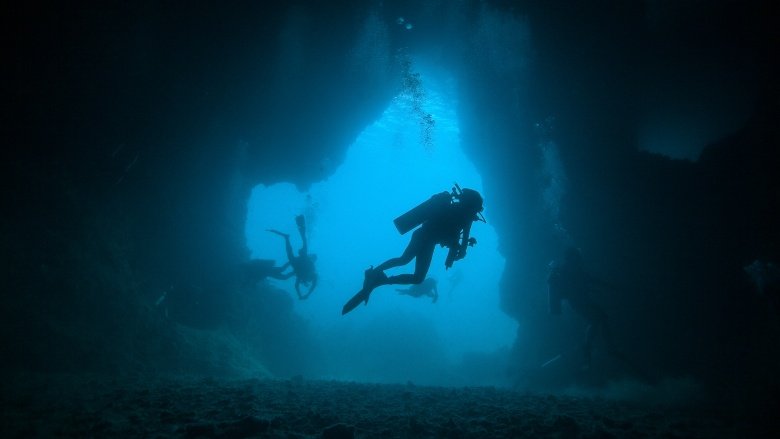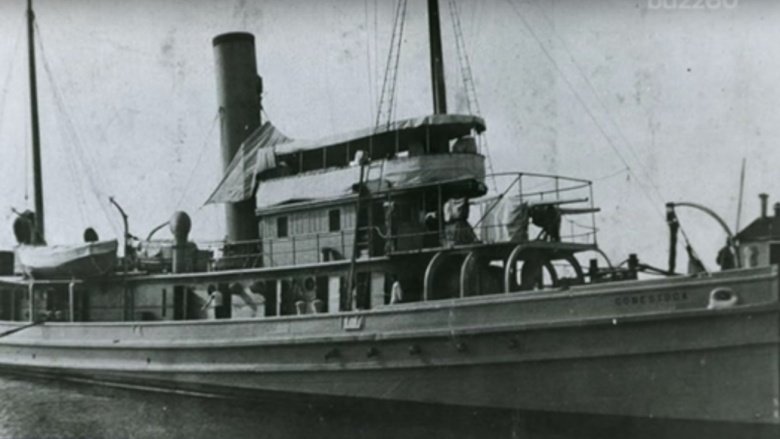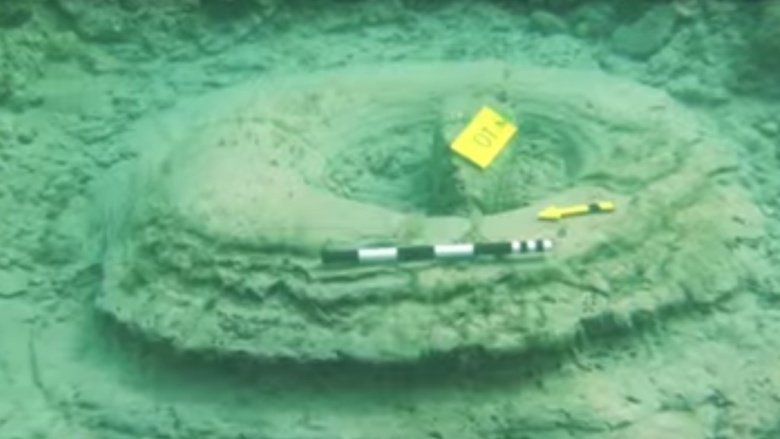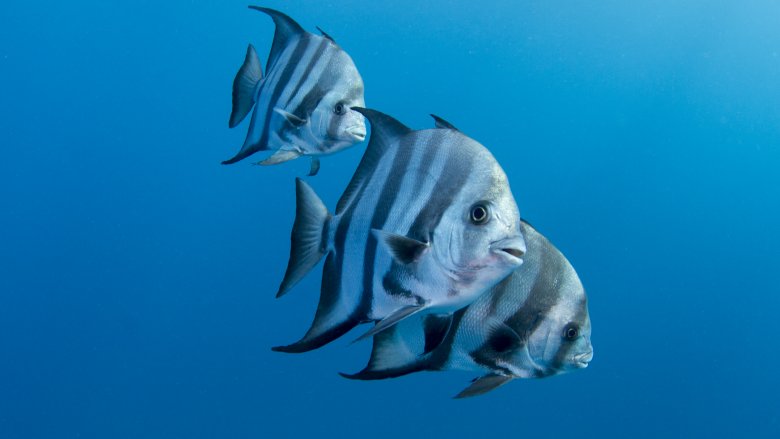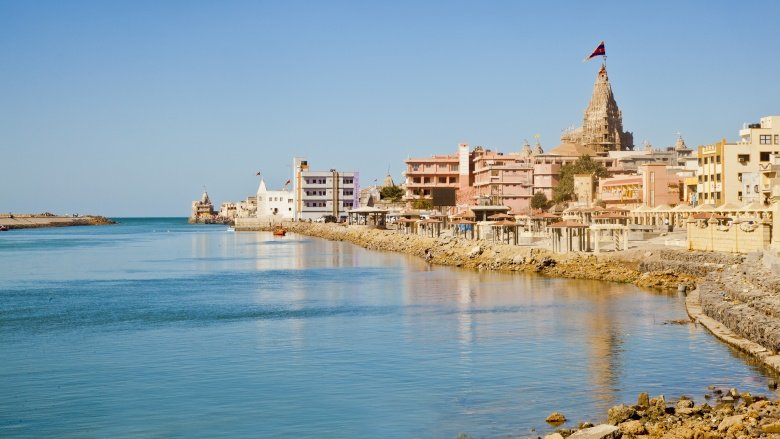The Real Stories Behind These Bizarre Ocean Discoveries
While space might be the final frontier, we have a much more immediate source of weirdness and mystery: the ocean. Undersea depths have long been the source of myth, legend, folklore, and the home to lost cities, sunken treasures and mysterious beasts. In many ways, these same stories are just as popular now as they were among sailors in ages past. As we explore the oceans, we discover ways in which our wildest sea tales and mysteries don't hold a candle to the real discoveries of the deep.
USS Conestoga
In September 2014, an expedition from the National Oceanic and Atmospheric Administration were in the Greater Farallones National Marine Sanctuary off the coast of California, when they discovered a mysterious wreck that didn't belong there. The weird thing was, the image they captured on sonar was way larger than any shipwreck ever reported in the area. Though divers soon figured out it was a 170-foot, coal-powered, seagoing tugboat dating from the late 19th or early 20th century, no one had any clue what it was doing there.
The NOAA's West Coast Regional Maritime Heritage Coordinator Robert Schwemmer took on the case and pored over old maritime records to try to identify the wreck. He compared old photographs of sunken vessels with images recorded by remotely operated vehicles (ROVs). He didn't have much luck, until he stumbled across a news article from 1921 that reported the USS Conestoga as missing en route to Hawaii. The vessel had been built as a tugboat, but was bought by the US Navy during WWI and fitted with light machine guns. The Navy launched the largest air and sea search ever seen in the hunt for the missing vessel, but came up empty-handed. It was the last US Navy vessel to vanish without neither trace nor explanation.
Schwemmer eventually realized the Conestoga had been launched from San Diego, but had stopped at Vallejo in San Francisco bay for repairs before setting off again for Hawaii. Perhaps the ship hadn't gone all that far. When an ROV captured an image of a machine gun on the wreck, they knew it was the Conestoga. The NOAA now had the answer to their mystery, and solved a nearly century-old military disappearance case to boot. It's now believed the tragedy was caused by rough seas and 40 mph winds, and the vessel and its unfortunate crew went down while searching in vain for a protective cove.
Zakynthos "Lost City"
After tourists diving near the Greek island of Zakynthos discovered structures shaped like disks and doughnuts, rumors spread about the ruins of an ancient lost city on the seafloor. Sadly Greek authorities investigated, and rained on the parade. They found no supporting evidence it was a sunken port city, nor any traces of human habitation near the weird structures, like pottery. Though Atlantis seekers were disappointed, the truth turned out to be even weirder.
Professor Julian Andrews of the University of East Anglia, and Professor Michael Stamatakis from the University of Athens, investigated the formations and determined they were the result of a naturally geological phenomenon called the mineralization of hydrocarbon seeps. This occurs in areas where natural gas lies under the seabed, but hasn't quite ruptured through, creating a kind of bulging pipe system. Methane is released into the sediment, and carbon from the methane is gobbled up by microbes living in it, who excrete a form of natural cement. This leads to crazy-looking formations that look like sunken buildings.
This also makes the structures way older than the ancient Greeks, having formed sometime during the Pliocene Age millions of years ago. These structures are actually not uncommon on the seafloor, but what makes the Zakynthos structures interesting is how they're in such shallow water, just 6-16 feet off beneath the surface. Similar formations in shallow waters can be found in the North Sea, and perhaps the only reason no one ever took those as evidence for a lost city, is that no one really wants to dive there.
Fish choruses
Fish are rarely known to sing outside animated children's movies, but they're actually quite a noisy bunch. Researchers from Curtin University listening to the vocal calls of fish off the coast of Port Hedland, Western Australia, discovered that fish actually sing in chorus at dawn and dusk, just like birds. Vocal calls are an important aspect of fish behavior, whether they're hunting for food, wooing a mate, or fighting over territory. They're also useful for scientists trying to monitor fish populations in murky and low-visibility waters.
The variety in fish calls is amazing, and not yet fully documented. The researchers at Port Hedland identified the foghorn-like drone of the black jewfish (Protonibea diacanthus), the baa-baa sound of a species of batfish (pictured), and the grunting of a Terapontidae species described by researcher Miles Parsons as akin to the "buzzer in the Operation board game." You'll never look at Game Night the same way again.
Thonis-Heracleion
Before the great city of Alexandria was built in 331 BC, the main trading hub between Egypt and the Greek world was the city of Thonis-Heracleion. But the problem for a long time was, no one had any idea where it was. It vanished over 2000 years ago, and only classical records spoke of its existence. It may not have been as glamorous as Atlantis, but it was just as big of a mystery. That is, until Franck Goddio came along. He was leading a team from the European Institute for Underwater Archaeology, surveying the seafloor topography near the modern city of Alexandria. They were hunting for 18th-century French warships, but discovered a lost city instead.
The very location which made the city a great hub for trade, also brought about its doom. After a series of natural disasters in the 2nd century BC, the clay soil of the central island went through a process of liquidization. As buildings are rarely designed to be built on water, this was a bad thing. Some dogged inhabitants stayed in the increasingly marshy area through the Roman and Arab eras, but the last hold-outs abandoned the area when their houses sank beneath the waves in the 8th century AD.
This discovery was huge. While some had believed Thonis and Heracleion were separate cities, Goddio proved they were simply one happy metropolis (until they sank). Excavation of the lost city has allowed archaeologists a peek into the cultural mixture of Ptolemaic Egypt. They've found the statues of Greco-Egyptian gods, humanized versions of the traditional animal-headed gods sculpted according to the Greek fashion. Luxury trading goods like Athenian perfume bottles and Cypriot incense burners attest to the very earliest forms of globalized trade.
One of the most bizarre discoveries was a stele erected outside a temple to the supreme god Amun-Gereb, inscribed in intricate detail on taxation and tariffs. What can we infer from this? Clearly tax dodging and smuggling was so out of control in the city, they needed fear of divine wrath to at least try to keep people honest. Hmm ... that might explain why it sank. Look out, Wall Street.
The mysterious purple orb
While exploring the underwater Arguello Canyon off California's Channel Islands with a remote operated vehicle, scientists aboard the research vessel E/V Nautilus discovered a bizarre, glowing purple orb creature on the seafloor. They were initially baffled as to what it was. The more sensible suggested it might be a species of tunicate, or "sea squirt," or perhaps the egg sac of some other animal. A more outlandish suggestion was that it could be a spider egg sac, in which case they better leave it where it is.
Wait, we've seen this movie. It was an alien spider egg, isn't it?
Don't worry, it wasn't. They decided to recover the creature with the ROV's suction tube. There was a moment when a crab wandered up and got in the way, presumably while screaming, "No, you fools!" like the Norwegians at the start of The Thing. But despite its best efforts, the glowing purple orb was successfully vacuumed up and set loose among the human population.
The sample revealed the orb actually had two distinct lobes, which suggested it was a species of pleurobranch, or sea slug. There are several thousand species of pleurobranches known to science, found in warm and cold waters all over the world, and which come in a variety of shapes, colors and sizes. They are absolutely normal and unlikely to do anything crazy, like eat the brains of the scientists on board the E/V Nautilus in order to build a beacon to attract thousands of glowing purple sea-spiders from space. Probably.
The San Jose shipwreck
When the San Jose, a Spanish treasure ship, was sunk by the British off the coast of Colombia during the War of Spanish Succession, it was a massive financial blow for King Philip V. But it created a legend, as shipwreck hunters knew that somewhere out there was a wreck stuffed with billions of dollars worth of treasure. In 2015, Colombian shipwrecks found it (allegedly). As you'd expect from an underwater haul of gold, silver and gems, people soon started fighting over it.
Colombia claimed dibs because the vessel is under its patrimony, and they could really use the money. Spain also claimed dibs, as it was a Spanish vessel and they have had a good track record with claiming galleon wrecks before. This argument is a bit weak though. If you lose $50 in your garden, move out of the house, and the new occupants find your $50 in the garden a year later, you don't get to suddenly demand it back. Finders keepers.
Meanwhile, a US salvage company called Sea Search Armada is crying foul. They claim they discovered the location of the wreck in 1981 and duly reported it to the Colombian government, only to find themselves mired in legal disputes. Colombia disputes this claim, and is keeping the exact location of the wreck a state secret. It's pretty easy to imagine shenanigans on both sides of that dispute.
Tensions between Spain and Colombia eased in March 2016 when the two countries agreed to cooperate on the construction of a museum to house recovered artifacts, which seems suspiciously reasonable. Differences remained, but the two sides agreed to come to a resolution at the next Iberoamerican Summit.
Gulf of Cambay "Lost City"
In 2002, oceanographers from India's National Institute of Ocean Technology (NIOT) were conducting surveys on the effects of pollution in the Gulf of Cambay (Gulf of Khambhat), when they discovered what they believed to be the remains of a 9,000-year-old city lying 120 feet beneath the waves. If such a discovery was confirmed, it would cause a major upheaval in our understanding of the ancient Indian civilization, as the oldest ruins in the region date from the Harappan civilization, which would make it only 4,000 years old. News of the discovery was published by the BBC.
Usually in these situations, when people are excited about a discovery that could change our entire conception of human history, there is good reason to be suspicious. The people most annoyed were Indian archaeologists. It turned out the NIOT didn't take any photographs of the site, and their idea of careful excavation was using a huge mechanical dredge to scour the seafloor. They also didn't even seek the advice of any actual trained marine archaeologists before announcing the discovery.
There were also objections to the way the supposed site was dated, based on the carbon dating of a piece of wood. Indian archaeologists pointed out the now-submerged area was once the site of an ancient forest during the Neolithic period. The piece of wood might just have been an ordinary natural piece of wood, scooped up unceremoniously with a bunch of artifacts that could have easily been dropped off the side of trading vessels in the region. A few objects the NIOT claimed were stone tools were dismissed as naturally-occurring eoliths.
Archaeologists in India believe the announcement of so-called discovery was motivated by political and nationalistic concerns, as it's always nice to have the oldest stuff. While the possibility of an ancient metropolis in the Gulf of Cambay has not been disproven, the archaeological community requires more scientific rigor in excavation, before making any wild claims.
Greenland sharks
Forget giant tortoises — it has recently been determined the oldest living vertebrate animal in the world may be the elusive (and deeply weird) Greenland shark. Marine biologists from the University of Copenhagen used carbon-14 dating on the sharks' eye lenses to estimate the creatures have a life expectancy of 270-500 years. That means a Greenland shark born during the Age of Discovery might be spending his old age griping about nuclear submarines and the water not being as cold as it used to be.
Greenland sharks are rarely seen, and are the largest and slowest sharks in the world, at over 20 feet in length and possessing a top speed of only 1.6 mph. Their flesh is also extremely toxic, keeping them safe from rival predators. While Greenland sharks are most often associated with the Arctic, it's suspected they range wildly in the deepest, coldest parts of the ocean. Despite their slowness, they are voracious eaters who prey upon fish as well as unlucky reindeer and polar bears who fall off ice floes. There is also evidence they eat deep sea carrion, which is super gross.
Many Greenland sharks are also blind, as over 90% of the population is infected with Ommatokoita elongata, a creepy parasitic crustacean which attaches to the sharks' eyes and damages their corneas. So next time you go swimming, remember somewhere out there is an ancient blind megashark that eats pretty much anything. Luckily, they're really slow. Wait, are these zombie sharks? They may be zombie sharks.
Kissing (and fighting) coral
Scientists from the Scripps Institution of Oceanography have used a new form of microscopic camera called the Benthic Underwater Microscope to capture images of coral behaving in strange and exciting ways. The system, deployed in Israel's Gulf of Eilat, is designed to capture millimetre-scale phenomena over a time-lapse at high resolution, allowing scientists to observe seafloor organisms and their behavior in greater detail.
Two coral polyps were observed connecting their gastrovascular openings, a behavior referred to as kissing, and believed to be related to an exchange of food or other material. This is fascinating, but also raises the question as to what exactly coral scientists think kissing is.
Coral polyps were also observed cooperating with each other in communal feeding. When corals of different species were placed together, they were observed emitting stringy mesenterial filaments used to attack and digest their enemies alive. This makes them racist, and also terrifying.
Lake Michigan "Stonehenge"
While Lake Michigan may not technically be an ocean, it's close enough for underwater work. Archaeologists were hired to survey the waters near Traverse City using specialized sonar equipment in 2007, where they discovered some interesting things: shipwrecks, an old Civil War pier, and even a submerged buggy. But the wildest discovery was an arrangement of ancient stones, some of which appeared to be natural while others looked manmade. The most stunning feature was what could be a petroglyph of an ancient mastodon, which coexisted with humans in the huge 10,000 years ago.
The discovery was invariably reported in the media as the Lake Michigan Stonehenge. Their discoverer, marine archaeologist Mark Holley, isn't happy about that characterization, preferring to call them the Great Traverse Bay Stones. His reasoning is that the stones aren't megaliths like Stonehenge, but are rather quite small, and they aren't arranged in a circle, but rather a vague line a mile long. Holley points to research into a similar line of stones found in Lake Huron, which were theorized to be the remains of a prehistoric drive line for herding caribou.
To get to the truth of the matter will require more dives by trained marine archaeologists as well as petroglyph experts, who are not usually known for their love of scuba diving. Sadly, state politics have interfered in any further exploration into the site, the exact location of which is being kept secret for security reasons. Basically, the right people to go down to the site can't get the funding they need, but they also can't reveal the location for fear of dive tourists wrecking the place. This is why we can't have nice things.
